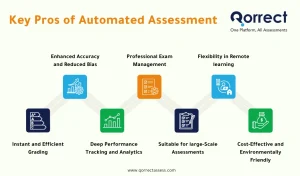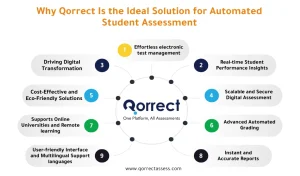Digital transformation in education plays a vital role in managing assessment methods. Traditional Vs automated assessment has been a key topic, as traditional assessment has long been the standard grading method, while transformational assessment focuses on evaluating outstanding performance. With the integration of organizational, management, and performance analysis systems, educational institutions are moving towards a robust evaluation system.
In this blog, we will discuss traditional Vs automated assessment, the major advantages and limitations, and why Qorrect is the ideal solution for educational institutions.
From Manual to Seamless
Table of Contents
What is the Traditional Assessment?
Traditional Vs automated Assessment is a key discussion in modern education. traditional assessment refers to manual grading, where professors evaluate student responses based on predetermined criteria. The traditional methods include the following types of tests:
- Essay Question, which requires subjective grading.
- paper-based exams with handwriting responses.
- Manually scored multiple-choice questions.
- Oral assessments, which are judged by human evaluators.
pros and cons of traditional assessment
When comparing traditional vs automated assessment, it’s important to note that traditional methods have been the standard method for evaluating student performance in educational institutions. While it offers certain advantages, it also comes with limitations, especially in the era of digital transformation in education.
Pros of Traditional Assessment
1-Flexibility in Question formats.
Traditional assessment allows a range of question formats like essays, oral presentations, and problem-solving exercises.
2-personalized feedback
Traditional assessment allows professors and instructors to provide detailed, individualized feedback to students.
3-familiarity and ease of use
Traditional assessments are familiar and easy to administer for many professors and students without requiring advanced technology or infrastructure. This can be beneficial in educational institutions that lack digital resources.
Stay tuned as we further explore the differences in traditional vs automated assessment and how educational institutions can transition toward more efficient evaluation methods.
Cons of Traditional Assessment
1-Time consuming grading process
Without automated grading, professors spend significant time manually grading exams. This can delay feedback, making it harder for students to improve in real time.
2-Risk of human bias in grading
Traditional assessment relies on human judgment, which can sometimes be inconsistent or biased. With student performance analytics, automated systems ensure a more objective evaluation process.
3-lack of real-time performance tracking
Traditional assessments do not provide instant insight into student progress. With performance analytics, professors can track learning trends, identify struggling students, and adjust teaching strategies accordingly.
4-Limited Scalability
For large-scale assessments, manual grading becomes impractical. Universities conducting thousands of exams can benefit from the digital transformation of education.
5-paper based challenges
Traditional assessment requires paper, printers, storage, and physical handling, leading to increased costs and environmental impact. these solutions eliminate challenges through digital transformation education.
In the comparison of traditional vs automated assessment, it is clear that automated methods provide greater efficiency, accuracy, and scalability, making them the future of educational assessment.
Read about: Assessment for Learning: The Role of MCQs and Safe Exam Browser in Modern Education
What is Automated Assessment?
Automated assessment refers to the use of educational technology to design, publish, and evaluate exams with minimal human intervention. This assessment method depends on electronic test management platforms to enhance efficiency.
Qorrect is considered a pioneering platform that transforms the assessment process across universities. From creating digital exams to publishing them, Qorrect platform streamlines the entire evaluation process, ensuring accuracy and efficiency.
Pros of Automated Assessment
In the rapid advancement of digital transformation, traditional methods of student evaluation have been replaced by automated assessment systems. These modern educational solutions leverage automated grading, managing electronic tests , and performance analytics to create a more efficient and objective evaluation process.
- Instant and efficient grading.
Automated grading instantly generates the results, reducing the professors’ workload and gives them the time to focus on enhancing teaching strategies. - Enhanced accuracy and reduced bias.
Automated grading ensures fair evaluation and controls human errors and biases. - Deep performance tracking and analytics.
professors can obtain insights about students’ progress, identify weaknesses, and customize learning strategies through accurate data analystics. - Professional exam management.
Universities can professionally manage exams through electronic test platforms, which securely create, distribute, and grade exams. - Suitable for large-scale assessments
Automated grading tools efficiently manage thousands of exams, ensuring a smooth and timely evaluation prosess. - Flexibility in remote learning
Digital Transformation allows students to take exams anywhere, any time. - Cost-effective and environmentally friendly
By minimizing paper-based exams in universities, automated assessment reduces administrative costs and helps protect the environment.
In the comparison of traditional vs automated assessment, automated methods offer greater efficiency, fairness, and scalability, making them the ideal choice for modern educational institutions.
Read about: 5 Ways Formative and Summative Assessments Revolutionize Learning

Traditional VS Automated Assessment: Which One Is Right for You?
Educational institutions are mostly transforming from traditional assessments to automated assessment systems as part of the broader digital transformation. While traditional methods have been used for decades, electronic tests and automated grading systems offer more efficiency, accuracy, and scalability. According to the pros and cons of traditional vs automated assessment, automated assessment is the ideal choice for institutions aiming to support digital transformation.
How Educational Institutions Benefit from Automated Assessment?
with the adoption of digital transformation, especially in the education sector. educational institutions are shifting from traditional grading methods to electronic grading.
Digital Transformation enhances efficiency and accuracy in the assessment process. In executive educations, it also improves exam management, making it more professional and positively impacting student performance.
key benefits of Automated assessment in traditional vs automated assessment
- Instant and accurate grading.
- Enhanced student performance.
- Advanced analytical reports.
- Streamlined management of electronic exams.
- Cheating prevention in exams.
- Safe exam publishing.
- cost-saving and sustainability.
- Improved accessibility and flexibility.
Read about: The Power of Bubble Sheets and Quiz Makers in Modern Teaching Methods
Why Qorrect Is the Ideal Solution for Automated Student Assessment
As educational institutions continue embracing digital transformation, the demand for an efficient educational assessment platform is rising. Qorrect emerges as a top platform, utilizing advanced automated grading, efficient test management, instant and accurate results, and enhancing education methods. Qorrect system is the ideal choice for educational institutions because :
1-Effortless electronic test management.
2-Real-time student performance insights.
4-Scalable and secure digital assessment.
5-Advanced automated grading.
6-Instant and accurate reports.
7-Driving digital transformation.
8-cost-effective and eco-friendly solutions.
9- supports online universities and remote learning.
10- User-friendly interface and multilingual support languages.

Get real-time results and actionable insights.
 Qorrect Blog
Qorrect Blog






